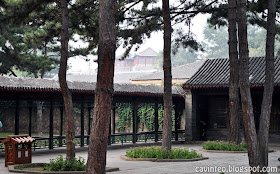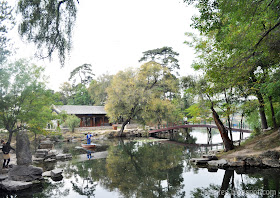避暑山庄, which literally means Avoid-The-Heat-Mountain Resort, is a vast area built specially by the emperors of the Qing Dynasty to spend the hot and humid summer away from Beijing.
Compared to the intimidating walls at Forbidden City, the gates and walls at the mountain villa gave the impression that they could have belonged to the wealthier commoners!
What i am going to cover here is barely 10% of the summer palace, which totaled 5.6 square kilometers! To put it simply in squarish term, it would mean an incredible length and breadth of 2.37 kilometers each!
Map of the resort; the main reason why i added Rehe to the subject was because that was the original name of Chengde and i happened to remember that because of a Chinese drama serial starring Li Baotian (李保田), my favourite actor from China! More on Jehol later. :)
Entrance tickets - the price for each person was 140 RMB! I am not sure why but the tour guide would always collect back the tickets to the attractions.
Pavilion near the entrance - like some of you, i thought the whole place had a dark gloomy atmosphere that just didn't make the cut for being a place to house the royal family!
Even the main court [known as 澹泊敬诚殿] where the emperors handled important state affairs, was merely a one-level building with an unassuming black-lacquered throne.
Don't be fooled by the apparent simplicity! The timber that was heavily mobilised for the construction of this building was Nanmu [楠木]; a type of hardy wood that barely grows an inch in a century. It's now super rare to find a Nanmu tree with a trunk similar to those wooden pillars in the picture.
Behind those blue curtains were books that were supposedly favoured by Emperor Qianlong even though i have my reservations that they have remained there since his death 300 years ago.
Despite the unexciting atmosphere, there were still little pockets of exquisiteness like the above.
I got bored after a while; the lack of visual appeal made it extremely difficult for me to concentrate on what the tour guide was explaining. To a certain extent, what she said was exactly what the emperors would do when they were back in Beijing.
And i am not interested to listen to the same story twice. Having said that, there was some amusing information like the row of servant quarters directly north of the main court that served as a border to the residential division of the royal family.
Honestly, i could not wait to get out of this compound and explore the great outdoors of the massive indoors (go figure what i meant)!
While the guide was giving a summary on the national humiliation of year 1860, i chanced upon this huge panel showing the direction to the residence of Empress Dowager Cixi.
Now, i have always been very curious about this powerful woman and had read substantially on her life when i was in my teens. Some researchers said she was a powerful manipulator in politics while others argued that she was merely a pawn in the game.
Her bedroom was so tiny! How could the bedrooms of the royal family be so small!?!?
Boxes of Nanmu incense sticks for sale! Besides being hardy, the wood has an additional benefit of being a natural insect repellent! Something i really need for my ant-infested room.
You cannot find any wooden stairs to the second floor of this building! Access was via the stone sculpture that had steps carved into it. Innovative!
Going out of the compound now! Shards of broken glass on top of the low walls - they seemed like a modern installation as this 'exit' led to the scenic spots within the mountain resort.
Stone branding the mountain resort.
With eight beautifully landscaped lakes set in the highlands, it was a relaxing stroll for all of us! It helped that the place was not overcrowded with visitors and the air was so fresh and crisp!
I could so laze around in the pavilion overlooking the lake!
The summer palace was a top filming spot for Chinese period dramas and we were lucky to see one production team in action! Wrapping up to be exact!
Given the long walk, we all took the payable option to take the electric tram to ferry us around. I would be fine to walk on my own although the tour guide did add that it would be faster if we took the tram.
Loyal fans of China's most popular drama serial, Princess Pearl (还珠格格), would remember seeing this before.
It was the original shooting location for the main abode of Princess Huanzhu; 漱芳斋!
The officially given name by the emperor is 烟雨楼 and it originated from the view of the above location in the picture.
You have to stand at the bank right opposite though. It was said that after a heavy rain, the building would appear to be shrouded in mystical haze that made the place extremely alluring.
Mom asking to take a shot!
At this time, our dear Chengde tour guide was recommending a pictorial book with a group photo we took earlier that could be bought with a nominal fee (I am getting numb). This kind of sales talk was more my dad's kind of thing.
Roof of a pavilion beside 烟雨楼. Oh, i forgot to mention that with the exception of the structure, please do not expect to find furniture or any decoration similar to what you see in the drama.
Taking the electric tram once again to another pavilion.
The stream we needed to cross, and there wasn't a damn bridge!
Thank goodness for these nicely layered rocks that dammed up the stream. Climbing up was an option but most people just took the easiest way out; stepping on flat rocks jutting out from the barely ankle level water.
Interestingly, the pavilion did not have flat surface flooring. Instead, it acted as a deviating route for the stream to pass by the 'dam'! According to the guide, this pavilion was often visited by the concubines.
Notice the tip of the pavilion in both pictures? One was straight when you look at it straight while the other was skewed to the left when viewed from the sides. The guide made it sound so fascinating! Wasn't that a simple case of parallax error caused by the curved roof beam!?
Drove past the Mongolian hut that were no longer made of cloth! So much for tradition and history! Nonetheless, i understand how high the maintenance can be if they are indeed made of cloth.
Finally - Rehe [热河 aka Jehol] which means hot river. I was expecting to warm (or even scald) my hand in the water but it was not!!! It was explained that the shortest river in the world (wasn't this a pond?) has an average temperature of eight degrees celcius and doesn't freeze over even in winter!
The name might have also come about due to the occasional hot steam emitting from the river in winter.
Water symbolises wealth! In actual fact, mom was busy trying out some almond nuts in a nearby store and could not be bothered with the river!!! I told her to at least test out the temperature before leaving!
A seventy-meter tall pagoda built in 1751. Taken from afar as our time was needed for another place.
Where else but the jewellery and deer antlers shop! I have to admit, once again, that the crystal drum my mom bought was quite nice.
Ending my short visit with a photograph of the mini great wall of Chengde summer palace. The wall stretched the entire perimeter; all 5.6 square kilometers of it!
.JPG)










































No comments:
Post a Comment